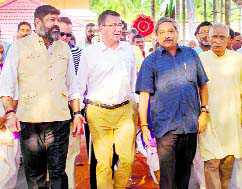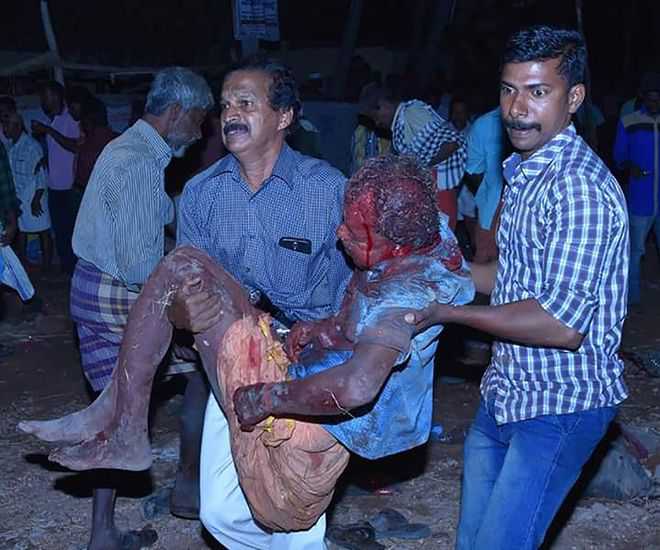The key airbase at Panagarh in West Bengal has been renamed as ‘Air Force Station Arjan Singh’ in honour of the Marshal of the Air Force, who turned 97 on Friday.

IMAGE: Indian Air Force Marshal Arjan Singh being congratulated by Former Prime Minister Manmohan Singh on his 97th Birthday Celebration at Akash Officers Mess in New Delhi on Thursday. Photograph: PTI
The renaming of the Air Force Station was announced by Chief of Air Staff Arup Raha at a function in Delhi to mark Singh’s birthday.
Addressing a simple renaming ceremony in Panagarh, Air Officer Commanding-in-Chief, Eastern Air Command Air Marshal C Hari Kumar said, “It is a proud moment for the Indian Air Force and the state of West Bengal.”
“He is an icon and a role model. We have to work hard to ensure that the name is suitably looked after in terms of capability and performance. It is for the first time that we have taken a conscious decision to rename an airbase after an individual,” Air Marshal Kumar said.
An icon of the Indian military history, Singh, the first Indian Air Force Chief to lead a young IAF into war in 1965, was hardly 44 years of age when entrusted with the responsibility.
Air Force Station Arjan Singh in Panagarh, approximately 150 kms from Kolkata, will house the C-130J military transport aircraft, capable of carrying out special operations. These planes will be flying with the Mountain Strike Corps along areas bordering China.
Singh was born on April 15, 1919, in Lyalpur (now Faislabad, Pakistan), and completed his education at Montgomery (now Sahiwal, Pakistan).
At the age of 19, he was selected to the Empire Pilot training course at RAF Cranwell.
His first assignment on being commissioned was to fly Westland Wapiti biplanes in the North-WesternFrontierProvince as a member of the No.1 RIAF Squadron.
After a brief stint with the newly formed No. 2 RIAF Squadron where the Marshal flew against the tribal forces, he later moved back to No.1 Sqn as a Flying Officer to fly the Hawker Hurricane.
He was promoted to the rank of Squadron Leader in 1944.
Singh led the Squadron against the Japanese during the Arakan Campaign, flying close air support missions during the crucial Imphal Campaign and later assisting the advance of the Allied Forces to Rangoon.
For his role in successfully leading the squadron in combat, he was awarded the Distinguished Flying Cross in 1944.
On August 15, 1947, he achieved the unique honour of leading a fly-past of over a hundred IAF aircraft over the Red Fort in Delhi.
After his promotion to the rank of Wing Commander, he attended the RoyalStaffCollege at the UK. Immediately after Indian independence, he commanded Ambala in the rank of Group Captain.
In 1949, he was promoted to the rank of Air Commodore and took over as Air Officer Commanding of an operational command, which later came to be known as Western Air Command.
Singh had the distinction of having the longest tenure as AOC of an operational base, initially from 1949-1952 and then again from 1957-1961.
After his promotion to the rank of Air Vice Marshal, he was appointed as the AOC-in-C of an operational command.
Towards the end of the 1962 war, he was appointed as the Deputy Chief of the Air Staff and he became the Vice Chief of the Air Staff in 1963. He was the overall commander of the joint air training exercise “Shiksha” held between IAF, RAF (Royal Air Force) and RAAF (Royal Australian Air Force).
On August 1, 1964, in the rank of Air Marshal, the Marshal of the Air Force Arjan Singh took over reins of IAF, at a time when it was still rebuilding itself and was gearing up to meet new challenges.
Singh was the first Air Chief to keep his flying currency till his CAS rank.
Having flown over 60 different types of aircraft from pre-World War II era biplanes to the more contemporary, Gnats and Vampires, he has also flown in transport aircraft like the Super Constellation.
In 1965, when Pakistan launched its Operation Grand Slam, with an armoured thrust targeted at the vital town of Akhnoor, Singh led Indian Air Force through the war with courage, determination and professional skill.
He inspired IAF to victory, despite the constraints imposed on the full-scale use of Air Force combat power.
Then Defence Minister Y B Chavan wrote about him, “Air Marshal Arjan Singh is a jewel of a person, quiet efficient and firm; unexcitable but a very able leader”.
He was awarded Padma Vibhushan for his astute leadership of the Air Force during the war.
Subsequently in recognition of the Air Force’s contribution during the war, the rank of the CAS was upgraded and Arjan Singh became the first Air Chief Marshal of the Indian Air Force.
He remained a flyer to the end of his tenure in IAF, visiting forward bases and units and flying with the squadrons.
He retired in August 1969, thereupon accepting Ambassadorship to Switzerland. He was Lieutenant Governor of New Delhi from December 1989 to December 1990.
Having been a source of inspiration to all personnel of Armed Forces through the years, government conferred the rank of the Marshal of the Air Force upon Arjan Singh in January 2002 making him the first and the only ‘Five Star’ rank officer with Indian Air Force.

































































